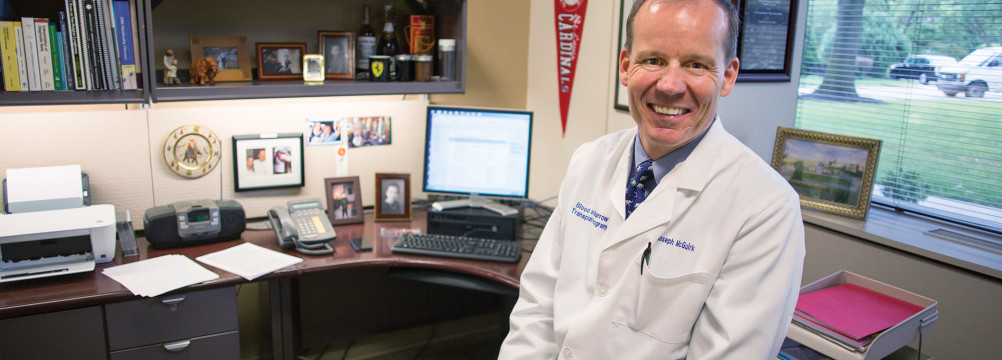
Dr. Joseph McGuirk is the director of KU Medical Center’s division of hematologic malignancies and cellular therapeutics.
by Joe Bollig
joe.bollig@theleaven.org
KANSAS CITY, Kan. — Dr. Joseph McGuirk strode purposefully through the Westwood Campus of the University of Kansas Cancer Center, chatting with a visitor about one of his favorite topics: treating the sick with stem cells.
McGuirk, a hematologist/oncologist, is director of the medical center’s division of hematologic malignancies and cellular therapeutics, part of the KU Cancer Center.
Simply put, he works to cure people of blood cancers through stem-cell transplants. Restoring people to health and saving their lives gives him a tremendous sense of fulfillment.
“It’s indescribable,” said McGuirk. “To be trusted, and for people to have confidence in you is extremely humbling. And it’s a profound responsibility.
“When things go well and you’re able to impact in a positive way in an absolutely devastating, terrible situation — some 18-year-old kid with leukemia, for example — that’s what it’s all about for us.”
Halfway up a stairwell, McGuirk had an unexpected but joyful reunion with one of his patients, Rebecca Hertzog.
“We took care of her when she had a very aggressive leukemia,” said McGuirk. “We got her cancer into remission, thank God. Unfortunately, she relapsed, and the only potential hope for her was a stem-cell transplant.”
The stem cells came from blood within the umbilical cord of a healthy mother and healthy newborn baby. The baby went to the nursery and the umbilical cord blood — which is normally thrown away — was saved and used to treat Hertzog.
“We used them to save her life,” said McGuirk. “She’s a year out from cord blood transplant and look how beautiful she is!”
Tears formed in his eyes as he listened to Hertzog praise him and his team.
“I couldn’t think more of them,” said Hertzog, 26, from Lee’s Summit, Missouri. “They took the best care of me. Through it all, they had my back. They listened to me if I had anything to say. They would do anything for me. All of them prayed for me. They are family to me.”
McGuirk beamed as he continued on his way. He and his team saved another life. That’s what it was all about.
From cutting edge to mainstream
Stem-cell research and treatments have gone from science fiction to science fact.
“This is cutting-edge medicine — as cutting-edge as it gets — as represented by stem-cell transplantation,” said McGuirk.
Stem cells are unspecialized kinds of cells that maintain the body and repair tissue. They can renew themselves and change into different types of specialized cells. Whenever the body grows, maintains or repairs itself — voilà! Stem cells are on the job.
Although stem cells were part of the first successful bone marrow transplant in 1956, it was only in 1961 that stem cells in the marrow were discovered. In 1999, researchers discovered that stem cells can be made to change into different kinds of cells.
Most of the progress in treating blood cancers with stem cells has occurred in the past 20 years.
“It’s been a steep learning curve,” said McGuirk. “The early years were fraught with very serious problems. We still have challenges and problems. If you look at survival outcomes 30 or 40 years ago, the patients we take care of had a 100 percent chance of dying. Today, we save half of those lives with this therapy. We are deeply thankful we’ve made that kind of progress, but we have a long way to go.”
Matchmaker, make me a match
Depending on their origin, stem cells can be categorized as embryonic or adult/mature.
In the case of human embryonic stem cells, the name says it all. The stem cells are taken from a human embryo, which is destroyed in the process.
In the case of human adult or mature stem cells, the stem cells can come from a variety of tissues: bone marrow, peripheral blood, skin, liver, muscle, pancreas, body fat, nasal tissue and the fetal life support system which includes the placenta, umbilical cord and particularly blood from the umbilical cord, all of which is discarded after birth.
“Cord blood transplantation, which really came about in the 1990s, has really become quite successful in the past 10 years,” said McGuirk. “Cord blood transplants have given rise to cord blood banks around the world, a number of them in the United States. There is no risk to the mom or baby, and it’s a waste product.”
In any case, it all starts with a donor.
“Those stem cells can be derived from several sources,” said McGuirk. “They can be derived from a brother or a sister or parent or child. They can be derived from someone not related to the patient. Indeed, in the case of bone marrow, there are registries of about 20 million people around the world who are willing to donate.”
Finding a match isn’t as hard as you might think.
“There are seven billion people in the world, not seven billion unique immune systems,” said McGuirk.
Nevertheless, rejection is still a serious problem, even with compatible donors. Currently, the KU Cancer Center is collaborating with another KU entity, the Midwest Stem Cell Therapy Center (MSCTC), to address the problem of graft-versus-host disease.
Stem cells good and bad
The writer Gertrude Stein once wrote, “A rose is a rose is a rose.”
Maybe, but you can’t say the same about stem cells. Some researchers will have nothing to do with embryonic stem cells.
“Embryonic stem-cell research is not ethical because it involves the destruction of a human embryo,” said Ron Kelsey, archdiocesan consultant for pro-life ministry. “Fetal stem-cell research is immoral if the fetal stem cells are obtained from aborted babies. By contrast, adult stem-cell research offers many opportunities to ethically search for treatments for various diseases.”
Sometimes, people believe that the Catholic Church is against any and all stem-cell research. Not so, said Father Gary Pennings, archdiocesan vicar general.
“The Catholic Church supports ethically acceptable stem-cell research,” said Father Pennings. “The church opposes the kind of stem-cell research that destroys human embryos or creates human embryos with the intention of harvesting stem cells from them.”
“The Midwest Stem Cell Therapy Center operates in a manner that is consistent with Catholic ethical principles,” he continued. “The church is very supportive of the kind of research that uses adult stem cells and stem cells from umbilical cord blood and [non-embryonic] tissues.”
Not only are embryonic stem cells ethically problematic, so far they simply haven’t produced cures.
“It calls into question if the utilization of embryonic stem cells is necessary, [and if] anyone needs to cross that line,” said McGuirk. “I would assert, ‘No.’”
“There is no scientific evidence that I have yet seen presented that convincingly tells us that there is an advantage to using an embryonic-derived stem-cell population,” he continued. “All the genes in an embryonic stem cell are present in these cord blood-derived stem cells, and we can get them without harming anybody.”
Embryonic stem-cell promoters claim these cells can do things other stem cells can’t. Not true.
“I’ve not seen any data to that effect, and I’ve read a great deal about this issue,” said McGuirk.
What about the potential for embryonic stem cells to produce cures? Such potential is only speculation. But it’s a fact that hundreds of thousands of lives have been saved using adult-derived stem cells without crossing ethical lines.
“Really, in the last 10 years, the debate has swung away — pretty significantly away — from embryonic tissues, as many investigators around the world have demonstrated we can accomplish these same things with adult-derived stem cells,” said McGuirk. “That’s an important point.”
So why the continued research into embryonic stem cells? Kelsey pointed to one reason.
“Embryonic stem-cell research will go on because the National Institutes of Health continues to provide millions of dollars for embryonic stem-cell research,” he said.
Good for what ails you
Stem-cell therapies have been used successfully to treat different kinds of blood cancers and other medical conditions as well. The list is short, but it’s growing.
Currently, stem-cell clinical trials include diabetes, multiple sclerosis, spinal cord injuries, stroke, heart disease, cornea damage and scarring, according to Dr. David A. Prentice, who serves on the advisory board of the Midwest Stem Cell Therapy Center.
“There are at present 3,098 ongoing or completed clinical trials using adult stem cells, listed in the [National Institutes of Health/Food and Drug Administration] approved database, with over 70,000 people around the globe receiving adult stem-cell transplants each year for dozens of different conditions,” said Prentice in testimony this year before the Kansas Legislature.
He further said that the applications of adult and cord blood stem cells in clinical therapies are growing, thanks to the collaboration between the KU Cancer Center and the Midwest Stem Cell Therapy Center.
“The KU Cancer Center itself performed over 300 marrow and blood stem- cell transplants for cancer treatments in 2013,” said Prentice. “It is anticipated that this year (2015) there will be over 340 transplants. To date, the KU Cancer Center has done more than 2,800 successful transplant procedures.”
What’s cooking in the kitchen
Tucked away in some surprisingly modest quarters of the University of Kansas Medical Center campus is the Midwest Stem Cell Therapy Center.
Although only created by the Kansas Legislature in 2013, the MSCTC has already become an important player in stem-cell research in the United States. Its director is Dr. Buddhadeb Dawn and it has a staff of seven.
The MSCTC has a number of objectives, which include: advancing non-embryonic stem-cell research and therapies, producing clinical grade stem cells for clinical trials and therapies; fostering a regional network of physicians trained in stem-cell use; maintaining a database of clinical trials and therapies; initiating stem-cell clinical trials; and educating the public.
In efforts to identify applications of center-produced adult stem cells, the MSCTC is working with KU Medical Center researchers and physicians to produce therapies and treatments for graft-versus-host disease; cardiac scar tissue repair following a heart attack;liver repair; spinal cord repair; stroke and traumatic brain injury repair; and Lou Gehrig’s disease (ALS).
“We are beginning to work with external research institutions and biotech companies to support their efforts in evaluating adult stem cells for specific disease applications,” said James W. Mitchell, manager for MSCTC’s Good Manufacturing Practices (GMP) facility.
“This involves production and the conduct of clinical trials. In fact, we will be initiating a new stem-cell clinical trial in the next one to two months in collaboration with an external company, investigating scar tissue repair following a heart attack,” Mitchell continued. “We are in discussions with three other external companies interested in working with the center that will hopefully result in the start of clinical trials over the next six months to a year.”
You can’t conduct clinical trials or preclinical investigations without stem cells, and the MSCTC produces them in its own “factory,” the GMP facility.
“The GMP facility is the heart of the MSCTC and provides clinical-grade stem cells from adult tissues and cord blood for clinical trials and for scale-up processing of cellular products for potential therapeutic use,” said Prentice, speaking before the Kansas Legislature.
The MSCTC GMP facility, said Prentice, is the only such qualified laboratory in this region and is on par with the best in the nation.
“We have yet to complete a full year of producing stem cells,” said Mitchell. “However, an estimate at our current rate generates about 50 billion stem cells per year, and our capacity is approximately 1.2 trillion stem cells using our current processes. We plan to expand this over the next one to two years.”
A bright and ethical future
In keeping with its legislative mandate, the MSCTC only works with stem cells derived from adult/mature (non-embryonic) tissues: fat tissue, bone marrow, the placenta and umbilical cord (which has a substance called Wharton’s jelly), and umbilical cord blood. Work with embryonic or fetal tissues cells is absolutely prohibited.
And it is because of this — and the MSCTC’s excellent work — that Archbishop Joseph F. Naumann and Father Pennings visited the center this May.
“I was very impressed by the professionalism of the staff, the advances they were making through their research and by their commitment to avoid any research that involves embryonic stem cells,” said Father Pennings. “In the field of stem-cell therapy, the regimens that have proven to be effective have been derived from adult stem cells.”
Catholics should not be involved with embryonic stem-cell research because that would be cooperating with the destruction of human life. That is not the case with adult stem cells.
“I would encourage Catholics to participate, in any way they can, with MSCTC — either by working as a researcher or in some other way supporting their work,” said Father Pennings. “They work exclusively with adult stem cells. The work being done at MSCTC is being conducted in an ethically acceptable manner and hopefully will save many lives in the near future.”
The staff at the MSCTC shares Father Penning’s optimism.
“I’m cautiously optimistic about the future of [adult] stem-cell therapies,” said Mitchell. “Data is just beginning to come in from human clinical studies regarding the safety and efficacy of a variety of stem-cell therapies. That said, this is an area that does hold tremendous promise, and all of us here at MSCTC and our collaborators are excited about the possibilities in the disease areas we are working in.
“Regarding the future of the MSCTC, I believe it is very positive, and we are looking forward to being able to meet the objectives laid out for us.”







Can steam cells be placed into my pancreas to help cure my diabetes. I take oral medications.